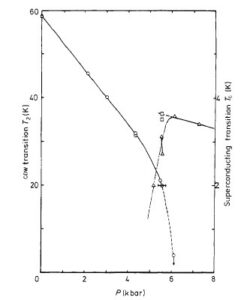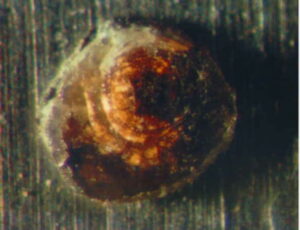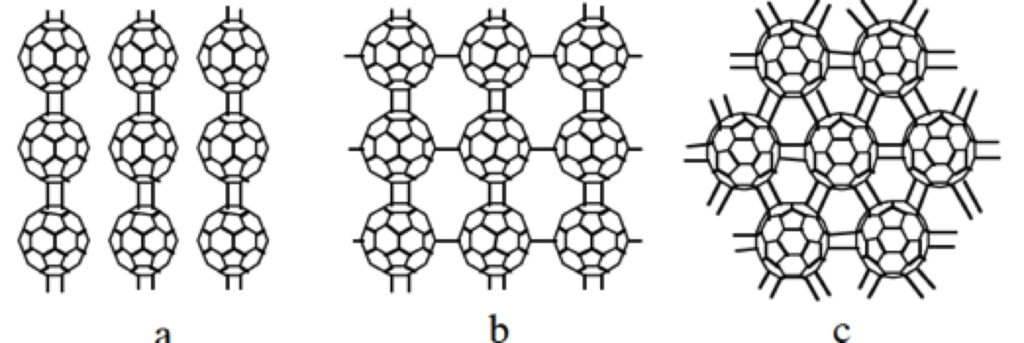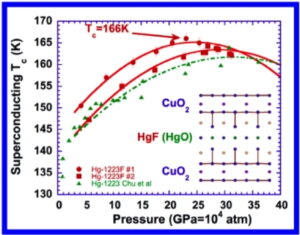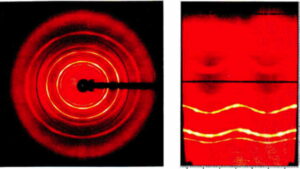- Home
- Institut Néel
- Research teams
- Technical Groups & Services
- Work at the Institut
- Partnerships

First observation of a quantum phase transition charge-density-wave : superconductor (NbSe3 under pressure). (J. Phys. C: Solid St. Phys., 13 (1980) 2117.)
Real space crystallography using dechanneling of alpha particles to study the structural transitions of 2D layered dichalcogenides. Solid State Comm. 54(1985)457

Order parameter of the excitonic insulator transition at 200K of 1T-TiSe2. Points: dechanneling; squares: neutrons.
The experimental determination of strong coupling properties of transition metal dichalcogenides through thermal conductivity measurements. Phys. Rev. Lett 55(1985)1931.
Thermal conductivity measurements of high-temperature superconducting cuprates, demonstrating the existence of two-level systems in these materials. Phys. Rev.B36(1987)8813.
The discovery of the transformation of C60 into diamond under high pressure at room temperature. Nature 355(1992) 237. (Diamond from C60)
Discovery of polymerized phases of C60 under high pressure and high temperature. This work has opened a new field of study on carbon compounds. Phys. Rev. Lett 74(1995)278.
The achievement of the highest ever observed critical superconducting transition temperature in a cuprate superconductor Tc=166K at 26GPa in Hg-1223-F. Science 262(1993)97; EPL72(2005)458.
The unique observation of permanent elliptical Debye-Scherrer rings in a three-dimensional structure phase of polymerized C60 under high pressure and high temperature. Science, 283(1999)1720.
The discovery of several superconducting compounds:
A Cu/C Cuprate Physica C 235-240(1994)2093.
The bismuthate : (Sr,K)BiO3 Nature 390(1997)148.
A superconducting phase with AlB2 structure (before MgB2) : CaSi2 under very high pressure. Phys.Rev.B61(2000)R3800; Phys. Rev B62(2000)11392
.
Superconductivity in the cuprate ladder compound without Sr : Ca14Cu24O41, Physica C351(2001)301
An Iron superconductor without Arsenic : LaFeSiH. Phys. Rev. B 109(2024)174523.
(Iron-based superconductors)
The determination of Luttinger liquid parameters in mono- and multi-walled carbon nanotube felts through transport measurements under very high pressure. Phys. Rev. Lett. 94 (2005)235501

We have verified that the exponent obtained for the power-law dependence of electrical conductivity (figure, left panel) is the same as that obtained for the voltage power-law dependence of dynamic conductivity (figure, center panel), as expected for tunneling in a Luttinger liquid. And, thanks to the variation of this exponentα (inversely proportional to the number of channels) we were able to verify the general expression for tunneling conductivity in a Luttinger liquid, a special case of quantum tunneling between two wells (figure, right panel).
The obtention of a memristor at 4.2K in Na0.47CoO2 by movement of the Na intercalates with current pulses. (Appl. Phys. Lett.93(2008) 152110) (Na-Cobaltites)

Resistance of Na0.47CoO2 sample at 4.2K as a function of time. We observe that current pulses in opposite directions (a) toggle the resistance between two different values. The stable value is that of the base resistance, and the movement and disorder of the interstitials induce the high value.
The determination of the pressure-temperature phase diagram in various one-dimensional compounds, enabling the development of a description of the interaction between charge density waves and superconductivity.
The first high-pressure studies combining transport and crystallographic properties in high-temperature superconducting iron compounds. These notably led to the discovery of the high-pressure, high critical temperature phase of FeSe. Europhys. Lett. 86 (2009) 27001. (Iron-based superconductors)
(Iron-based superconductors)
The first experimental evidence of the orbital Kondo effect in a compound, 1T-Cr1–xVxSe2. Phys. Rev.B 88(2013)245129.
First experimental demonstration that the effects of a quantum critical point existing at T=0K are observable up to very high temperatures (~600K). Phys. Rev. B 92 (2015) 205123.
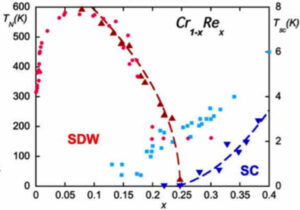
Quantum effects at high temperature: the quantum law (red dashed line), that emerges from the Quantum Critical Point at T=0K, starts to be followed at 600K. Triangles: our measurements; points : previous measurements.
The discovery of the first room temperature Van der Waals ferromagnetic compound: 1T-CrTe2. J. Phys.: Condens. Matter 27 (2015) 176002 .
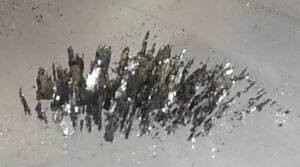
1T-CrTe2 platelet crystals under applied vertical magnetic field at room temperature, showing in-plane ferromagnetic easy axis.
The study of orbital and magnetic order in Ruddlesden-Popper chromates. Anomalous inverted Jahn-Teller effect in Sr2CrO4 , EPL 127(2019)27002 and Peierls orbital singlets in Sr3Cr2O7 , Phys. Rev. Lett. 118 (2017)207207.
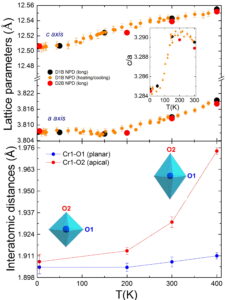
Anomalous Inverted J-T effect, i.e. deformed octahedron at high and symmetric one at low temperatures
Obtention of high temperature superconductivity in bulk twisted graphite by room temperature de-intercalation of KC8, with Tc‘s= 110, 245 and 320K. (Carbon 201 (2023) 667)(SC in Bulk Twisted Graphite)
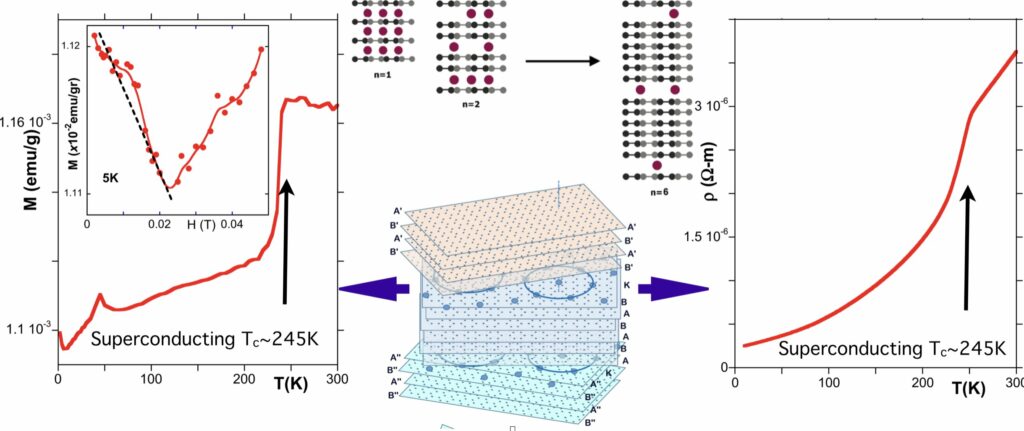
Upper middle panel: sketch of the de-intercalation reaction finishing in the six-fold intercalate. Lower middle panel: pictorial representation of an individual twisted crystal. Right panel: electrical resistance of a sample showing the superconducting transition at 245K. Left panel: magnetization measurement showing the superconducting transition at 245K. Inset: magnetization as a function of field at 5K showing the Meissner effect.
Fullerene carbon allotropes: C60, C70, etc. the effect of pressure
While graphite has a sp2 hybridization, and diamond, a sp3 hybridization, fullerenes have structures curved by twelve pentagons allowing intermediate hybridizations, sp2.3 for C60, and lie between these two well-known allotropic forms. The resulting properties are exceptional.
Unlike graphite, which becomes superconducting below around 10K temperatures when doped with alkali metals, C60 has a superconducting critical temperature of around 30K under the same conditions.
My contribution to this field of solid-state physics in collaboration with J-L. Hodeau was to find that C60 was transformed into polycrystalline diamond and amorphous sp3 carbon at room temperature by the application of a high non-hydrostatic pressure alone. We, with L. Marques, also drew up a stability diagram for C60 , and discovered new polymerized C60 phases
Focusing on the transformation into diamond, we note that it is of significant physical interest, as C60 is the only phase where this happens at room temperature. There are several reasons for this. The geometry of C60, with its intermediate hybridization and the possibility of high sp3 stacking. The instability of C60 in the face of anisotropic forces, allowing the energy of formation to be recovered at the moment of bursting and, as suggested by a recent theory, also the intermediate formation of lacunar graphite, unstable in the face of cubic diamond formation.
Electrical resistivity of fullerenes under pressure: unconventional behavior
C60 is an allotrope of carbon that has only been massively available since late 1990. I set about studying it under pressure to determine possible phase transformations. As a first step, I subjected samples of this powdered material to compressions of up to 250kbar, measuring their electrical resistance (Nature 354(1991)289). At low pressures, the resistivity, as well as the gap at a given temperature, decreased as if tending towards a metallic state. The variation of resistivity with temperature was anomalous, as it did not correspond to the inverse exponential of temperature expected for an ideal semiconductor. In fact, resistivity follows an exp{(T0/T)-1/4} law (three-dimensional variable range hopping) which reflects the fact that carriers are localized, either by the presence of dissolved oxygen, or as a consequence of the existence of disorder, probably due to a non-correlated orientation of the molecules. The same dependence was observed for C70 and C60I4. (EPL 21(1993)49 )
C60 transformation at high non-hydrostatic pressures
As I applied pressure, the conductivity of the samples increased. However, at a critical pressure value that depended on the existing pressure gradients in each cell, I observed that the samples eventually became insulating. Transitions to a lower symmetry state had been observed by another group under similar conditions. Most likely, when the C60 molecules had come close enough together, sp3 bridges formed between them and conductivity was affected. But what was the structure of this new phase? A way had to be found to obtain samples of this phase in order to perform a crystallographic analysis. To do this, I compressed without a pressure-transmitting medium and obtained hard, transparent samples. Analysis by X-ray diffraction and electron microscopy done by J-L. Hodeau showed the obtention for the first time at room temperature of polycrystalline cubic diamond. ( Nature 355(1992) 237. )
Raman characterization of the diamond obtained
Raman spectrometry is widely used to study carbon phases, as it is highly sensitive to the degree of carbon coordination. In samples obtained from the transformation of fullerenes, measurements performed by L. Abello and G. Lucazeau of UGA determined the existence of cubic diamond was clearly detected by the peak at 1330cm-1. There is also a broad band at around 1450cm-1, not common in carbon phase spectra, which may be due to the amorphous, tetrahedral-coordinated phase (Phys. Rev. B 46(1992)9903(R) ).
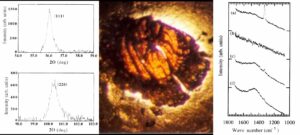
Center: Diamond obtained from C60 only by pressure. Left: X-rays spectra showing the cubic diamond peaks. Right: Raman spectra showing the 1330cm-1 peaks of cubic diamond.
Experiences at LURE
More precise crystallographic determination of the transformed samples was required. The X-ray diffraction spectrum obtained using synchrotron radiation confirmed the previous results. The fullerene samples transformed under high pressure contain only two phases: cubic diamond and an amorphous carbon with almost totally tetrahedral coordination, a type of amorphous diamond of which our samples are the first massive example (Phys. Rev. B 50(1994)10311).
More recently the group lead by J-L. Hodeau has performed a detailed X-rays tomographic study on one of my diamond samples showing clearly all the carbon phases present in them. A majority of cubic diamond, amorphous sp3 and Sp2 carbon, and the previously not reported compressed graphite. (PRL 109 (2012)025502)
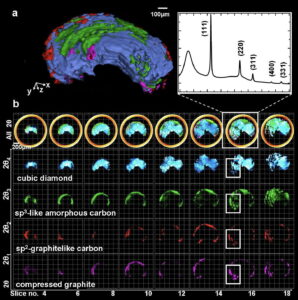
(a) 3D-DSCT image of polycrystalline cubic diamond, sp3-like amorphous carbon, sp2-graphitelike, compressed graphite and quartz capillary. Voxel resolution is 6:6 m 6:6 m 8:0 m 0:067 (x y z 2 ). (b) 2D-DSCT slices for each phase and their evolution with sample height (slice no.) for the full 2 range, and for representative d spacing (2 i). For slice no. 16, squares indicate the region of interest plotted in Fig. 2 and the inset shows the 1D scattering pattern for the summed contribution.
Collaboration with J-L. Hodeau and L. Marques
We discovered these new forms of carbon and led the study of their properties for ten years. Our work has given rise to numerous publications in prestigious journals, and has been featured in long chapters in books on the subject, as well as in popular articles.
As with other unsaturated organic molecules, C60 polymerizes under the combined action of pressure, which brings the molecules closer together and enables the cycloaddition reaction, and temperature, which generates long-range ordered polymerization, giving us new forms of carbon based on C60 with original properties.
Chemical reactivity in molecular solids is largely controlled by the molecular conformation and stacking of the molecules in the crystal structure. In the particular case of organic compounds such as C60, there may be unsaturated C-C bonds in each molecule that will become the reactive sites. Indeed, under the action of the polymerization agents we described in the first paragraph, these unsaturated bonds will react with those of neighboring molecules to give rise to dimers and, if the orientation with neighboring molecules is correct, polymers. In fact, in C60 molecules can, through cooperative rotational movements, move into the correct position to bond to each neighboring molecule without shifting their center of mass.
Temperature enables directed polymerization
We have shown how the application of high pressure at room temperature leads to partial polymerization, ball crushing and diamond formation. The reason for this behavior lies in the fact that bringing the C60 molecules together facilitates the formation of 2+2 bonds, but at the same time prevents free rotation of the molecules. This occurs even at very low pressures ~ 5000 atmospheres, below the pressures required for polymerization. Fortunately, we can maintain the free rotation of the molecules by supplying them with energy through an increase in temperature. This type of high-temperature (up to 1500°C), high-pressure (up to 80,000 atmospheres) experiment is possible on samples weighing around fifty milligrams in the belt presses of PLUM/IN. We have therefore been able to carry out a systematic study of C60 transformations in this pressure and temperature range. ( Phys. Rev. B 54(1996)R12633 ;
Samples processed above ~ 800°C are completely transformed into microcrystalline graphite at all pressures, so the molecular structure of C60 is lost. However, below this temperature, we obtained a multiplicity of new phases and phase mixtures. The samples obtained are insoluble in toluene, as are the photopolymerized phases. Their X-ray analysis showed that the C60 cage structure is intact but, more importantly, the inter-molecule distances are shorter.
1D and 2D polymer phases
Identifying the indexations of the X-ray diffraction lines corresponding to each phase was not as straightforward, as at this stage of the study we were often dealing with phase mixtures exhibiting very broad reflections. However, an analysis of the polymerized structures compatible with the original face-centered cubic symmetry, and with the arrangement of double bonds necessary for 2+2 cycloadditions between C60 molecules, solved this puzzle. The only possible structures are: a) a phase of orthorhombic symmetry formed by linear chains of polymerized molecules; b) a pseudo-tetragonal phase formed by quadratic planes where each molecule is connected by 2+2 cycloadditions to the first four neighboring molecules in the original fcc (100) plane; and c) a rhombohedral phase where each molecule establishes bonds with its first six neighbors in the high-density (111) planes of the original fcc structure. A description of the X-ray spectra by these three structures enabled us to interpret all the samples we obtained in the Pressure/Temperature range studied.
We subsequently established a collaboration with G. Scuseria of the theoretical group at Rice University in Houston – USA, where fullerenes were discovered. The metastability of the phases we had proposed was clearly demonstrated. They provided us with individual atomic positions compatible with their calculations and our symmetry constraints, enabling us to optimize the simulation of our X-ray diffraction spectra.
Our samples were also analyzed by the group of A. Rao and P. Eklund of the University of Kentucky using the same highly sensitive Raman spectrometer that had detected the photopolymerization of C60. New Raman lines signaling the polymerization of C60 molecules were thus revealed.( Phys. Rev. B57, R3193(1998); Physica Status Solidi (b) ,545(1996);
(Phys. Rev B55(1997)4766 ; Applied Physics A: Materials Science and Processing 64 231 (1997) ;
However, what chemists still lack is the definitive proof: the measurement of Nuclear Magnetic Resonance (NMR) lines. Indeed, in a free C60 molecule (as is the case in the face-centered cubic solid phase), all carbon atoms are equivalent, and there should be only one NMR line for a C13 atom. Polymerization, by deforming the molecule, generates several inequivalent atoms. In the case of the rhombohedral phase (figure c), there are six types of atoms: one type corresponds to the 12 atoms that establish inter-molecular bonds and have an sp3 character; the other five correspond to atoms with an sp2 character. Measurements carried out in collaboration with F. Rachdi of the Groupe de Dynamique des Phases Condensées at the University of Montpellier, using NMR with rotation at the magic angle, yielded these same inequivalent atom ratios on rhombohedral samples that we had synthesized with C60 enriched in C13. These results unambiguously confirmed the pressure polymerization of C60 .(Phys. Rev. B 54(1996) R3676 ; J. Phys. Chem. Solids 58(1997)1645, Applied Physics A: Materials Science and Processing 64 295 (1997))
Since polymerization can be 1D (orthorhombic phase a) or 2D (pseudo-tetragonal phase b and rhombohedral phase c), we determined the pressure-temperature diagram for C60 in the range permitted by our facilities. It’s interesting to note that it’s temperature that allows molecules to rotate, and hence the possibility of establishing ordered networks of polymerized C60. It therefore plays a key role in the formation of polymerized phases, while pressure is responsible for bringing the molecules together.
High-temperature superconducting oxides
The origin of the high-temperature superconductivity of cuprates, discovered in 1986, is still not fully understood. They exhibit an antiferromagnetic ground state, which disappears with e- or p-type doping, giving rise to the superconducting state in a manner similar to that observed in Charge Density Compounds compounds. While it is now accepted that many of their properties derive from antiferromagnetic fluctuations, many ingredients seem to be missing, as no theory predicts all the observed results.
Thermal conductivity of these systems
At the very beginning, we carried out the first measurements of the thermal conductivity on ceramic samples of these materials, finding a dependence close to T2 at low temperatures and almost constant behavior at high temperatures. At the superconducting transition, a slight change in slope was observed, reflecting the disappearance of holes as heat carriers. Given the certain existence of disorder in these oxygen-deficient materials, we proposed an interpretation in terms of phonon scattering by two-level systems analogous to those found in disordered substances (Phys. Rev., B36(1987)8813). This accorded well with acoustic attenuation measurements measured by P. Esquinazi showing the characteristic plateau of phonon relaxation absorption by two-level systems (Phys. Rev., B37(1988)545).
Thermal conductivity of antiferromagnetics at high Néel temperatures
In ceramic samples of the undoped compound La2CuO4 (TN=270K) and the cupric oxide, CuO (TN=235K), we have shown the significant effect that the antiferromagnetic order transition of these materials has on phonon thermal conductivity. Above the antiferromagnetic transition temperature, spin disorder is seen by phonons through a strong, and as yet unknown, spin-phonon interaction. The result is a constant mean free path for phonons, and the thermal resistivity clearly breaks down into a T-dependence due to the phonon-phonon process and the constant term due to disorder. Below TN, the spins order themselves and diffusion decreases. There is a clear recovery of thermal conductivity. This type of phenomenon had not previously been observed, as measurements had been limited to lower-temperature antiferromagnets .
Significant acoustic attenuation anomalies in copper oxides
Acoustic attenuation is a highly sensitive measure of relaxation processes. As well as detecting which systems are relaxing, it can give us an idea of the origin of these processes. On YBa2Cu3O7 we were among the first to determine the existence of two peaks near Tc. It was subsequently determined that they were not directly related to the transition to the superconducting state, but rather corresponded to the following posibilities: (i) interaction effects between the spins of copper atoms; (ii) hopping of oxygen atoms and vacancies; (iii) the elastic anomaly that accompanies the superconducting transition. A third peak, located at lower temperatures, probably has the same origin as (i) or (ii). Comparing our results with those of other groups at other frequencies, we found an activation energy of 65meV for this last peak. We found an anomaly at the same temperature for equivalent frequencies (Sol. State Comm.(1988) 65, 957) in Bi2Sr2CaCu208, but which does not correspond to relaxation, as it is independent of frequency.
Uncondensed carriers can explain the linear specific heat term of La1.85Sr0.15CuO4
We have measured the thermal conductivity under magnetic field, the specific heat at low temperature and around the superconducting transition of this compound. We have seen a dependence close to T2, to which a linear term is added at very low temperatures. The latter disappears under magnetic field conditions according to Kohler’s law, as if it were electric carriers. This strongly suggests that non-condensed carriers exist in this compound. In support of this hypothesis, we also found an excellent correlation between the linear term and the magnitude of the jump in specific heat at Tc. Of all the interpretations of the anomalous linear term in the low-temperature specific heat of La1.85Sr0.15CuO4 (and by extension YBa2Cu3O7), this is the one with the most experimental evidence. (Annales de Physique(1988)13, 401)
The thermal conductivity of Nd1.85Ce0.15CuO4 differs from that of other superconducting copper oxides: importance of apical oxygens
We found that the thermal conductivity of this high-temperature superconductor is an exception in the family: not only is it not constant at high temperatures, increasing as the temperature decreases, but at low temperatures it exhibits a behavior close to T3, in addition to a linear term that disappears under magnetic field conditions. The latter contribution starts at the antiferromagnetic order temperature of Nd ions, which we determined on the same sample using specific heat. A complete analysis shows that it is probably due to magnons. The absence of the T2 term due to two-level systems, and of the constant mean free path due to high-temperature disorder, suggests that the oxygens responsible are those placed on the vertices of CuO6 octahedra, absent in copper oxide with Nd. Indeed, it has been found by other research groups that these oxygens oscillate very anharmonically between two equilibrium positions at high temperature (resulting in phonon scattering through the existing disorder). At low temperatures, they are likely to freeze in one of the two wells in a disorderly fashion (giving rise to the two-level systems detected by our techniques). (Phys. Rev. B44(1991)9727)
Mercury superconducting cuprates: the 160K barrier
Superconducting cuprates are formed from CuO2 planes separated by rare-earth cations, and doped by layers of another type of oxide (Bi-O, Tl-O), interspersed with each one, two, three (or more) copper oxide planes. These layers introduce connection stresses that affect the superconducting properties of the CuO2 planes.
Since a quantum leap following the discovery of the thallium cuprate in 1988, critical temperatures for high-temperature superconductors have been unable to exceed 125K. J-L. Tholence and M. Marezio from our laboratory, in collaboration S. Putilin and E. Antipov from Moscow University, have now tackled the difficult task of synthesizing cuprates with mercury oxide as the doping layer.
They achieved this synthesis by working under high oxygen pressure in a sealed ampoule, or under quasi-hydrostatic high pressure, to avoid decomposition of the mercury oxide. The resulting compound had a critical temperature of 94K, which is high for a CuO2 single-plane cuprate. Critical temperatures of 127K and 133K were then obtained for the two- and three-layer compounds respectively. The dumbbell coordination of mercury does not favor strong mechanical strength of the Hg-O layer; consequently, there is no connection stress with the CuO2 planes.
My contribution to this study was the spectacular increase in critical temperature obtained very recently at a pressure of 23GPa up to 166K in the fluorinated compound Hg-1223, a temperature never before achieved by a bulk superconductor. Analysis of the data led us to conclude that it was not charge transfer under pressure that was responsible for the spectacular rise in Tc, but rather the reduction in the tetragonal parameter a that favored this high Tc. Unfortunately, chemists have since been unable to obtain cuprates with such low values of a at ambient pressure without introducing buckling of the CuO2 planes . It is possible that our experiment was the one giving the highest possible critical temperature of these compounds (Science 262(1993)97; EPL72(2005)458.).
Variation in the critical temperature of fluorinated Hg-1223 measured in our group compared with that of Hg-1223 measured by the Houston group. The critical temperature of the fluorinated compound is observed to be higher, reaching 166K at around 23GPa. This is the highest superconducting critical temperature and would be the limit for cuprates.
Carbonated copper cuprates
The search for new phases obtained under pressure led to the discovery of phases where the mercury oxide layers are replaced by Cu and CO3 layers, and where the number of CuO2 planes is greater than two. The three-plane phase has a Tc~70K, while the four-plane phase has a Tc=117K. There is also a third phase whose structure remains unknown, but which has a Tc=126K. We investigated all these phases using pressure resistivity measurements. We found that for samples synthesized at the highest pressures, the Tc of the three-plane phase decreases, that of the four-plane phase varies little, and that that of the highest Tc increases with the application of pressure exceeding 136K. This result has the advantage of a phase without toxic elements (mercury or thallium) with operating temperatures close to 140K. (Solid-State-Communications. 97(1996)131)
Double and gold-doped mercury cuprates
The aim of pressure experiments in these materials has been twofold: (a) to find new compounds; (b) to understand the sharp rise in critical temperature in mercury cuprates. In the first instance, it should be noted that achieving the optimum carrier concentration for superconductivity is not at all obvious in phase-mixed samples, as is common in this research. The study of behavior under pressure makes it possible to follow the variation of Tc with the doping rate in the different phases simultaneously, and to determine in a single experiment the initial doping rate, the one that maximizes Tc and, very importantly, the value of this optimum Tc. Working closely with the Crystallography Laboratory, this approach has enabled us to optimize carbonate cuprates, boron cuprates and other new compounds. On the experimental side, understanding the increase in Tc under pressure in mercury cuprates required numerous experiments on overdoped compounds (Hg-Au-1223) or with two layers of mercury Hg-2212. It also required a thorough study of the causes of the change in properties of the various cuprates under pressure, of the variation in their structures under pressure, and of the various theories in vogue to explain its effects. In short, we came to the conclusion that the anomalous increase in Tc observed in mercury cuprates is due to the pressurized approximation of the different CuO2 planar packets (Solid-State-Communications97 (1996)131;Phys. Rev. B57(1998)R5630).
Superconductivity in Overoxygenated Cuprate Ladders
High-temperature superconducting cuprates have CuO2 planes as their active structure. It was predicted that CuO-type scales could also be superconducting, with a mechanism similar to the base. And indeed, superconductivity could be detected in the compound Sr14-xCaxCu24O4 under pressure, with compression aiding charge transfer between the two structures present. However, the pure compound Ca14Cu24O41 had not yet been studied due to difficulties in synthesis. The chemists at ETH Zürich now have an apparatus that enables them to work at oxygen pressures of around 15Kbar at 100°C. They succeeded in making this compound. Our pressure transport measurements show that this compound becomes superconducting, and would indicate that better quality samples could be superconducting even at ambient pressure (Physica C351(2001)301).
High-pressure charge density waves in cuprates.
The origin of the interaction responsible for high critical temperature superconductivity (HTS) remains an extremely controversial subject. In recent years, the existence of charge orders (COs) competing with superconductivity has been observed in most SHTC cuprate families. They were observed in the underdoped region of the HTS cuprate phase diagram in coincidence with the, as yet misunderstood, pseudo-gap. This fact seemed to suggest that their study could provide a new key to understanding the problem. In particular, the question is whether these OC orders are intrinsic to HTS physics. Most recently, we have been studying new high-quality single crystals of mercury cuprates. Surprisingly, we observed OC under a pressure of 10GPa in the overdoped region of the phase diagram. In this region, the material is a normal Fermi liquid and no exceptional properties, which could be related to the anomalous physics of HCAs, are expected. This calls into question the hypothesis of the importance of OC for HCAs. However, a complete study of crystals with different doping rates is needed to clearly identify the behavior of these materials under high pressure. (Condens. Matter 6 (2021)25)
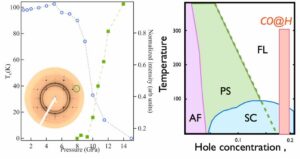
Left. Evolution with pressure on a single crystal of Hg-1201: (blue circles) of the superconducting critical temperature and (green squares) of the intensity of the superstructure spot (surrounded by a green circle in the synchrotron diffraction pattern) attributable to the charge density wave. On the right. Phase diagram of superconducting cuprates at high critical temperature, showing that our results show that, despite always competing with superconductivity, charge density waves in cuprates can appear in the normal Fermi liquid region. OCs are therefore not linked to the mechanism responsible for high-temperature superconductivity and are, possible, a red herring.
Iron-based superconductors
It was shown that compounds based on tetrahedrally coordinated iron layers (LaOFeAs, BaFe2As2, FeSe) can become superconductors at temperatures above 53K, a critical temperature only exceeded by cuprates. This discovery has renewed hopes of finally deciphering the phenomenon of superconductivity (SC) at high critical temperatures (Tc). Understanding the interactions responsible for this macroscopic quantum state would lead to the long-awaited goal of obtaining a superconducting material at room temperature. These new materials are composed of FeX planes (X=As, P, Se, Te) separated by layers, such as LaO, which act as charge reservoirs. Starting from an antiferromagnetic ground state, which is coupled with orthorhombic distortion, the introduction of electrons or holes kills this order and the material becomes superconducting. It is very important to study the interrelation between these different transitions, in particular the phase diagrams. This is because the ordered state in competition with the SC results from the same interaction undergone by the electrons.
The FeSe
This material is unique in that it has no pnicture, which facilitates synthesis. It has been shown that, at low pressure, its critical temperature rises sharply. At the Institut Néel, we reacted quickly and began a study in collaboration with ESRF. At high pressures, we demonstrated the existence of a high-Tc orthorhombic phase, Tc~ 37K.Europhys. Lett. 86 (2009) 27001

FeSe high-pressure phase diagram: a phase transition to an orthorhombic structure occurs at around 12GPa, the pressure at which a sharp increase in Tc is observed.
Pressure evolution superconductivity, structure and electronic bands (TSB)
I’ve made a major effort on these materials to set up a network of collaborations between Institut Néel members and ESRF and other groups, so as to be able to carry out measurements and calculations as a function of pressure. In other words, first the compounds are synthesized by P. Toulemonde (PLUM/IN). Then I make transport measurements to study the evolution of superconductivity. This is followed by characterization at ESRF by G. Garbarino (ID30), which identifies structural deformations. Finally, band-structure calculations performed by R. Weht of CAC/CNEA , Argentina, on the measured atomic positions help to understand the origin of these phenomena.
In particular, we have explained the empirical correlation tetrahedral angle – Tc for two compounds.
1) The case of SmFeAsO0.83F0.17
This sample, synthesized by the high-temperature-high-pressure method, is in the overdoped regime. We observed that the Tc increased rapidly, reaching a maximum value of 56K (possibly the highest Tc observed in compounds to date), and decreased at higher pressures. Structural measurements showed that this Tc maximum coincided with a regular FeAs4 tetrahedron, as reported in several review articles. Band structure calculations using the measured atomic positions indicate that this maximum is due to the fact that, only for this configuration, there is a charge transfer between the SmO and FeAs layers, which reduces the electronic concentration of these latter planes. The sample is thus returned to a state with optimum doping. (Phys. Rev. B 84(2011)024510)
2) The case of Sr2VO3FeAs
This compound has the particularity of being superconducting in the stoichiometric phase, unlike all other pnictures, which have an antiferromagnetic ground state. We applied the TSB method to a sample provided by the compound’s discoverer, Prof. Hai Hu Wen of the Beijing Academy of Sciences.
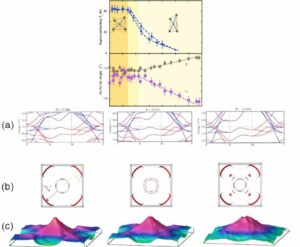
Top of figure: evolution up to a pressure of 30GPa of Tc and the tetrahedral angle of Sr2VO3FeAs. (a) band structure at different pressures, (b) Fermi surfaces derived from Fe orbitals at different pressures (c) electronic susceptibility calculated at different pressures.
In the band-structure calculation at ambient pressure, we see that, unlike other pnictures, there are multiple susceptibility peaks , , capable of triggering antiferromagnetic order. As explained by Moriya’s “self-consitent renormalization” theory, this multiple “nesting” considerably reduces the transition temperature (defined by the temperature T for which ) towards the main antiferromagnetic order to Q=1/2, as . Thus, the e-e interaction due to antiferromagnetic fluctuations is used to generate the superconducting state, which explains the peculiarities of this compound. The main effect of pressure is to induce deformation of the FeAs4 tetrahedron, which removes the degeneration between the {zx + yz} and xy bands. This results in the separation of cylinders in gamma, strongly reducing the secondary electron susceptibility peaks at ¼ (see the evolution of these peaks with pressure in figure c), and the system can therefore develop an antiferromagnetic state despite the superconducting state. (EPL 96(2011)57002)
The case of CaFeAsF and SrFeAsF
These compounds of the 1111 family (iso-structural with SmFeAsO0.83F0.17) behave in a surprising way under pressure. The transition temperature to the antiferromagnetic state (determined by the peak of the derivative of the electrical resistivity) decreases at low pressures, but presents a minimum to increase again around ~10GPa, as shown by measurements by D. Freitas of Niteroi, Brazil. This minimum is accompanied by a change in symmetry: the orthorhombic distortion disappears at around this pressure. The effect of pressure is totally distinct from the effect of electron doping produced by the replacement of oxygen by fluorine. We have calculated the pressure evolution of the electronic band structure. We observe hole doping of FeAs planes under pressure, which weakly affects the peak electron susceptibility. This behavior may explain the differences, as electron doping rapidly destroys the susceptibility peak. In addition, a change in the antiferromagnetic order in the monoclinic symmetry phase is theoretically achievable. We show that pressure can be the way to study hole doping in 1111s, which is very difficult to do chemically (J. Phys. Cond Matter 26 (2014)155702).
New LaFeSiH superconducting phases, non-toxic Fe-based superconductors.
The discovery of high-temperature superconductivity in iron compounds in 2007 opened up a new avenue for understanding the origin of unconventional high-temperature superconductivity, as for the first time we had a new family of HTS compounds. However, these compounds – based on arsenic, such as LaFeAsO-F or BaFe2As2, or on selenium, such as FeSe – have the major drawback of being toxic, which would obviously limit their use.
In 2016, the groupo of S. Tencé found that solid-gas hydrogenation is the appropriate synthesis for obtaining new iron HTS of the LaFeSiH type (ZrCuSiAs-type structure). DFT calculations done by F. Bernardini and A. Cano suggesterd its sueprconductivity.
However, the existence of a ferromagnetic impurity and the granular nature of the samples had jointly prevented observation of the superconducting state. It was in fact, my experiment under pressure performed together with G. Garbarino that revealed the existence of superconductivity. This is the first iron-based HTS synthesized without toxic elements. (Phys. Rev. B 109(2024)174523)
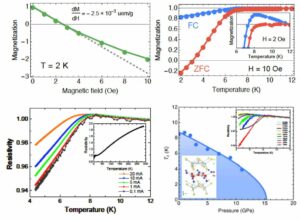
Top left: measurement of magnetization as a function of magnetic field, showing the diamagnetism of the samples. Top right: measurement of magnetization as a function of temperature, showing the appearance of the Meissner effect at around 7.5K.
Bottom left: measurement of electrical resistance at 1GPa at different currents, showing that the small anomaly observed is indeed due to superconductivity. Bottom right: superconducting transition temperature as a function of pressure, with resistance curves at different pressures in the right-hand insert, and the crystallographic structure of LaFeSiH, a non-toxic iron-based superconducting compound, at the bottom.
Ceramic lamellar triangular cobaltites.
Triangular cobaltites of the NaxCoO2 type have been studied for some time for their high thermoelectric power. It was discovered that they become superconducting by the intercalation of water molecules for the concentration x~0.3. On the other hand, their properties as a function of Na content are not well understood, as we expect a magnetic material where we observe a paramagnetic one and vice versa. With G. Garbarino, we measured the transport properties as a function of temperature and pressure for different sodium concentrations in collaboration with R.J. Cava of Princeton University. We have observed that the different spin density wave transitions increase with the application of pressure. And we have shown that the main effect of pressure is to effect a charge transfer, as in the case of superconducting cuprates, quantitatively 10GPa being equivalent to a variation of – 0.1 in the concentration x of Na. (Phys. Rev. B 77(2008)060105)
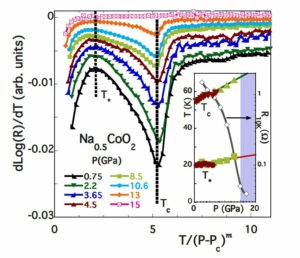
Logarithmic temperature derivative of the resistance of two Na0.5CoO2 samples triangular symbols, sample C; other symbols, sample D as function of temperature scaled by |P−Pc|m, with Pc=−28± 5GPa and m=0.6±0.05. Inset: Pressure dependence of the low temperature transition temperatures Tc (triangles ) and T* (dots and squares) for two Na0.5CoO2 samples (dark symbols, sample C; light symbols, sample D). The solid lines represent the scaling dependences Tci0 · |P−Pc|m. We also show the 2 orders of magnitude fall of the 10 K resistance (R10 K, white diamonds ), which occurs while the transition temperatures increase with pressure. The region in pressure where the samples have a metallic behavior is shaded.
Single-crystal lamellar triangular cobaltites.
Institut Néel’s crystallogenesis group lead by P.Lejay has developed a new procedure for making crystals of NaxCoO2 cobalt using a technique derived by M. Armand. Single crystals with a ratio of approx. x=0.8 are fired in an image furnace. Subsequently, a soft-chemical treatment was used to control the doping rate down to around x=0.5. These samples were characterized by resistivity measurements, and measured using ultrasonic and high-pressure techniques. Elastic constant measurements revealed significant anomalies linked to the transitions observed in these compounds. On the other hand, resistivity measurements showed that the anomalies for samples with x=0.5-δ did not lead to an insulating state, as previously reported, but to a fundamental metallic state at low temperatures. However, temperature cycling following the application of 1GPa pressure led back to the insulating state. G. Garbarino set out to find other ways of controlling this behavior, and it turned out that applied current pulses at 4K switched the resistor between two states depending on the bias applied. The result is a low-temperature RRAM (resistance random access memory) device. In addition, heating above liquid nitrogen temperature erased these effects, allowing these samples to be considered as cold-chain controls (Appl. Phys. Lett.93(2008) 152110).
Sr2CrO4
We have studied the physical properties of this compound. Magnetic measurements show an antiferromagnetic order around TN=150K. Neutron crystallographic measurements at ILL enabled us to determine the magnetic structure and the evolution of atomic positions as a function of temperature. Contrary to expectations, the magnetic order corresponds to a spin density wave, suggesting a roving type of magnetism (Fig.). Our specific heat measurements, with an almost undetectable anomaly around 150K, support this interpretation. In addition, DFT calculations confirm the existence of a nesting vector coinciding with the magnetic order wave vector.
Analysis of the evolution of atomic positions with temperature yields an extremely interesting result. In general, we expect CrO6 octahedra to change from ideal high-temperature octahedra, corresponding to a degeneracy of the electronic d levels, to elongated octahedra, causing a break in the degeneracy of the d levels, in what is known as a Jahn-Teller effect. In Sr2CrO4, we observe the opposite behavior, i.e., an astonishing inverted Jahn-Teller effect. DFT calculations help explain this apparent anomaly. In a nutshell, the Jahn-Teller effect described above implies that the interaction between Cr and O is purely ionic, whereas if the interaction were covalent, the result would be a contraction of the octahedra. We have here an intermediate situation caused by this unexpected result, due in part to the non-equivalence between O1 and O2. ( EPL 127(2019)27002)
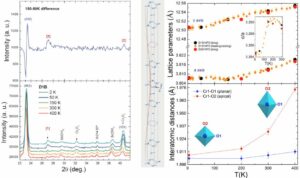
Left: neutron spectra used to determine the structure of the spin density wave-like magnetic order (center). Right: evolution of CrO6 octahedra, with an astonishing reverse Jahn-Teller effect, with an apparent increase in symmetry at low temperatures!
Sr3Cr2O7
We had to master the difficult conditions of high-pressure-high-temperature synthesis, and then carry out a complete characterization of this almost unknown material. We gather the expertise of PLUM and MCBT colleagues at the Institut Néel. Then we determined the magnetic structure at ILL and the details of atomic motion at transitions at ESRF. Finally, I asked two independent theoretical groups, one at MCBT/IN and the other at CNEA/Argentina, to provide a theoretical basis for the interpretation of our results. In this work, which involved seventeen researchers, we demonstrated orbital Peierls singlets in the compound Sr3Cr2O7, the existence of which we reported for the first time (Phys. Rev. Lett. 118 (2017)207207.).
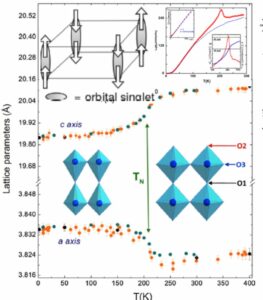
Evolution of the double-plane structure of the compound Sr3Cr2O7 as a function of temperature, showing the distortion observed, associated with a contraction of the c-axis and a dilation of the a-axis. Top right, the specific heat measured on the compound, with a strong anomaly at TN=210K, with an entropy close to Rln6, implying the existence of an orbital order at the same time as the antiferromagnetic order. Top left, the state of the orbital singlets suggested by the Lanczos calculations we made, and confirmed by experimental measurements.
A new phase: Ba19Cr12O45
We tried to study the Ba-based Ruddelsden-Popper family. Unfortunately, none of the lamellar compounds could be synthesized. However, we discovered a new compound with stoichiometry Ba19Cr12O45. By complementary X-ray and electron diffraction measurements, we determined its new cubic structure, with non-equivalent Cr sites suggesting different valences. (Journal of Solid State Chemistry 251 (2017) 164)
The discovery of superconductivity in Moiré graphene multilayers opens the era of superconductors by design, as there is no theoretical limit for the value of their transition temperature. However, it is impossible to guess the geometry optimal for superconductivity, as the possibilities are innumerable. We show here a synthesis for testing all the geometries in the same bulk twisted graphite. We report that our samples show granular superconductivity at room temperature.
Recently, a new carbon material has been rendered superconducting: hand made stackings with several graphene layers twisted by a small angle. From this Moiré device emerges an arrangement of macromolecules, where there is a superposition of carbon atoms of different layers.
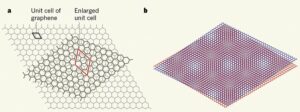
The lattice structure of graphene and a Moiré stacking of two layers twisted by an angle. The emerging macromolecules due to the regions of carbon atoms superposition and the new enlarged cell are shown on the left panel. A more pictorial image for a smaller angle is shown on the right panel.
The resulting electronic structure has very flat bands that are held as responsible for the superconductivity, presently with an empirical bound at about 10K. Although there is no theoretical limit for the transition temperature, the number of Moiré candidates is inaccessibly large, as the stacking possibilities (number of layers, twisting angles) are practically infinite. Additionally, the manufacture of Moiré nano-devices is extremely difficult, rendering the search for higher transition temperatures an impossible lottery.
We have designed a method for constructing in the same bulk sample crystallites all possible twisting and doping configurations. We first synthetize at 250°C KC8, the potassium intercalated graphite compound where all the graphene planes are exactly one on top of the other. We then extract at room temperature the potassium by soft chemistry. The slow chemical kinetics of the reaction causes a disordered collapse of the KC8 structure and a residual potassium content. X rays measurements performed at the European Synchrotron Radiation Facility show mainly six-fold stackings with arbitrary twisting angles, which depend on the local residual potassium concentration. The obtained bulk twisted graphite statistically contains all the possible six-fold configurations in the same sample.
The magnetization measurements done at Institut Néel and verified at the Laboratoire de Physique des Solides, show that graphite’s important diamagnetism is replaced by a ferromagnetic behavior. Furthermore, transitions to diamagnetic states are observed at 110K, 245K and 320K. The appearance of one or other transition temperatures depend on the synthesis protocol of the samples, i.e. starting material, synthesis time, etc. The fact that magnetic field cycles show hysteresis proofs the superconducting character of the diamagnetic transitions. Coherently, the cycles shrink with increasing temperature and disappear at the transition, as expected for a superconducting state.
For the 245K phase, we obtained almost zero resistance in electrical resistance measurements, which allowed the study of the effect of magnetic field on the transition temperature. It is extremely small, yielding a gigantic zero temperature critical magnetic field of 1200±200 Tesla, more than ten times greater than the largest presently known critical field. In fact, it is the value expected for a Moiré system with such a transition temperature.
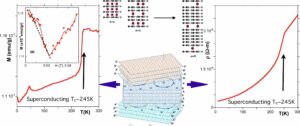
Upper middle panel: sketch of the de-intercalation reaction finishing in the six-fold intercalate. Lower middle panel: pictorial representation of an individual twisted crystal. Right panel: electrical resistance of a sample showing the superconducting transition at 245K. Left panel: magnetization measurement showing the superconducting transition at 245K. Inset: magnetization as a function of field at 5K showing the Meissner effect.
Our measurements show the maximum possible transition temperatures, but do not tell us which is the exact Moiré configuration for these superconducting states. By construction, the number of crystals with the structure and doping necessary for superconductivity is tiny and hence, of granular character. More work is needed in order to increase their number and the superconducting volume, and to isolate the configuration of each superconducting phase.
Charge Density Waves systems
The subject of charge density waves exploded in the ’70s, following Little’s work predicting a high superconducting critical temperature for one-dimensional compounds. It was soon found that there was another type of transition that competed with the superconducting state: the charge density wave (CDW) or Peierls state.
This arises when, as a result of the particular Fermi surface shapes of certain materials, particularly those of low dimensionality, electronic susceptibilityχ (q) diverges for certain periodic distortions (phonons) of vector Q. The response of the electronic Fermi sea to this distortion becomes strong enough to re-normalize the phonon energy of the same Q (Kohn anomaly). This strong electron-phonon coupling stabilizes a periodic lattice distortion that traps carriers, making the material less conductive. This results in the appearance of a small gap in the Fermi surface (a few tenths of an eV).
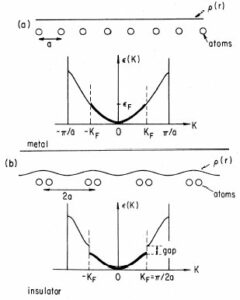
Peierls distortion in a one-dimensional metal with a half-filled band.(a) undistorted metal.(b) Peierls insulator.
e- or p-type doping of the compound changes the Fermi level, which in most cases results in a reduction inχ (q) divergences. The distortion is no longer the ground state of the system, but the strong residual interactions that remain give rise to a superconducting state.
The effect of pressure is similar to that of doping, leading to a gradual disappearance of ODC in favor of superconductivity.
Transition metal trichalcogenides.
Transition metal tri- and tetra-chalcogenides have a chain-like structure, formed in the first case by successive triangular prisms. In the second case, the chains correspond to transition metal atoms enveloped by chalcogenide “tubes”. The linear structure gives these compounds a strongly one-dimensional character. As a result, portions of the Fermi surface are suitably calibrated to cause a maximum of the electronic linear response function cq. The resulting charge density wave is highly stable, often rendering the material totally insulating.
First observation of a quantum critical point with the appearance of a superconductivity pocket around it.
The NbSe3 compound, discovered in 1975, exhibited two ODC’S at temperatures of 145K and 59K. Preliminary high-pressure magnetization measurements had shown signs of superconductivity. As we expected the pressure to harden the soft phonon of the ODC and destabilize it, we made measurements of electrical resistivity as a function of temperature down to 0.7GPa so that we could simultaneously observe the evolution of the ODC’s and any superconductivity. We observed that the low-temperature ODC disappeared around 0.6GPa and that superconductivity developed around this pressure J. Phys. C: Solid St. Phys., 13 (1980) 2117.). These measurements represented the first observation of what became, with the study of heavy fermions ten years later, one of the central topics of solid state physics – the influence of quantum critical points on the phase diagram of systems, in particular superconductivity. In recent years, I have discovered a formula to explain the coexistence of ODC’s and superconductivity around a quantum critical point(Ref.134).
New phase of TaS3
Studies on TaS3 started on samples that we believed to be of the known orthorhombic structure. However, I found that the resistivity signalled the presence of several phase transitions, prompting further analysis of the samples’ structure. The result was the detection of a new monoclinic phase, isomorphic with NbSe3, and which had, like the latter compound, two phase transitions. More interestingly, I showed that this TaS3 monoclinic phase also exhibited non-linear resistivities, verifying that this phenomenon was common in these compounds (Journal de Physique Lettres,40, L-157(1979)).
m-TaS3 behavior under pressure
The two charge density waves that develop in m-TaS3 have different reactions to the application of pressure. The lower-temperature wave behaves as expected, i.e. TODC2 decreases as the lattice hardens. On the other hand, the higher-temperature one increases up to a pressure of around 30kbar , and then starts to fall as expected. In these compounds, the strong one-dimensional fluctuations lower the transition temperature relative to that defined by the charge density wave gap. The observed variation in TODC1 suggests that the increase in inter-chain coupling caused by the application of pressure decreases the one-dimensional fluctuations and allows the transition temperature to rise. At higher pressures, network hardening blunts this process, and normal behavior is restored (Synthetic Metals, 55-57, 2653(1993)).
Layered transition metal dichalcogenides
Uniaxial stress and ODC stacking phases in transition metal dichalcogenides
The 1T-TiSe2 compound exhibits a transition where small pockets of electrons properly calibrate central pockets of holes, developing an excitonic insulator. This results in a significant resistivity anomaly below the transition at 200K. In my early magnetic field resistivity measurements, curious anomalies occurred on cooling. It was assumed that, by analogy with chromium, stresses due to differential thermal contraction were the cause. I designed an apparatus to apply uniaxial stresses up to 1kbar, and found that these modest stresses changed the magnitude of the transition by a factor of two. The origin of this effect was attributed to stacking of the ODCs of layers with lower symmetry than the original distortion (Ref. 11). Taking up the theory successfully used in 2H-TaSe2, I showed that antiphase domains must exist, which would be ordered by the action of strain. Electron microscopy measurements subsequently confirmed this conclusion. Similar effects were found in 1T-TaS2. (Ref. 12)
Decanalization of He ions+ : a real-space crystallography technique
When a charged ion is accelerated against a crystal, it can only penetrate if it has an entry angle that allows it to enter between two Bragg planes, and more easily with their intersection. By measuring backscatter as a function of angle, we find low-count lines with, at their intersections, veritable wells where particles have rushed into the crystal: channels. This phenomenon can provide important structural information. We have taken advantage of this information to study the deformation produced by the charge density wave. We determined that only a certain number of channels are affected by this transition, confirming the (more costly) neutron diffraction measurements. In addition, we have followed the evolution of this deformation with temperature, thus finding the temperature dependence of the gap Ref. 15).
Thermal conductivity of charge density wave compounds :
the case of an order-disorder transition
Because of their fragility and small size, it is difficult to measure the thermal conductivity of these compounds. This led me to develop new measurement techniques to deal with these problems: the differential technique and the serial dynamic technique. Using the former, I measured the compounds NbSe3 and 1T-TiSe2. In both cases, there is a T2 law at low temperatures, which cannot be explained by dimensional effects. In the high-temperature region, I observed the appearance of a maximum at a temperature of the order of half that of the transition to the charge density wave, corresponding to the completion of the transition.
Using the dynamic technique, we measured 1T-TaS2 and 2H-TaSe2. In the first case, the behavior is extremely curious: at the incommensurable -> almost commensurable transition, conductivity drops by around 20%, while at the “lock-in” transition it rises sharply by 40%! The explanation lies in the loss of the electronic contribution at the first transition and the increase in the free path of phonons thanks to the order established by commensurability. On 2H-TaSe2, the behavior seems more normal. Nevertheless, the transition temperature of the charge density wave is well marked and a recovery in conductivity is observed. I noted that this material is characterized by a resistivity analogous to that of magnetic metals: it could be decomposed into a linear part (phononic contribution) and a constant part (disorder contribution) that disappears below TODC: surprisingly, the transition is more order-disorder than gradual. The application of this idea to thermal conductivity fitted in very well with our results. The specific heat also showed an entropy of transition close to Rln2, and the soft phonon responsible for the transition never fully softens. All this explained the discrepancy between the gap value and the actual magnitude of TODC without appealing to fluctuations due to dimensionality, which are small in this case. (Ref. 16)
Circles: thermal conductivity of 2H-TaSe2; dotted line: electronic component calculated by Wiedemann-Franz; cross: lattice component; solid line: phenomenological fit assuming that the transition to an ODC is actually an order-disorder transition of ODC fluctuations that appear at temperatures 3.5kB T*~ 2Δ , whereΔ is the optically measured ODC gap. This type of analysis explains why transition temperatures measured by other properties are lower than the average field transition temperature T*.
Charge density waves and superconductivity in 2H-TaS2 and 2H-TaSe2
We have studied the behavior of these two compounds at very high pressures, attempting to track transitions to their respective charge density wave (CDW) states and their correlation with superconductivity. We have performed electrical resistivity and magnetic susceptibility experiments under pressure. We found very similar phase diagrams, with, at low pressures, a significant increase in the transition temperature Tc to a superconducting state, associated with a descent in the transition temperature to the charge density wave. However, at the moment of transition from incommensurate to commensurate for the ODC vector, the decrease in its transition temperature TODC fades away. We can therefore correlate the evolution of the incommensurate TODC with the superconducting Tc, which is expected since these phenomena are strongly linked to the Fermi surface, whereas the commensurate T(ODC) is linked to the entire band and phonon structure (Phys. Rev. B 93 (2016))84512)
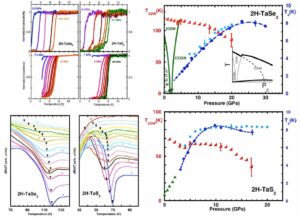
Left and top: evolution of superconducting transitions measured by electrical resistivity and magnetic susceptibility. Left and bottom: evolution of the derivative of electrical resistivity, whose peak helps us determine TCDW-s. Right: phase diagrams, showing the sharp increase in Tc at low pressures, which can be correlated with the incommensurable T(CDW) variation, as shown in the insert above.
Department: MCBT
Team: Magnetism and Superconductivity (MagSup)
Status: Personnel Chercheur
Structure: CNRS
Position: Permanent
Email: Manolo.Nunez-Regueiro@neel.cnrs.fr
Phone: 04 76 88 78 38
Office: E-311

